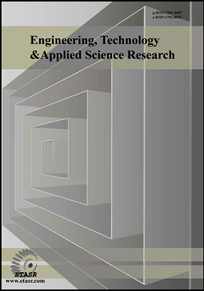Effect of Nozzle Diameter and Raster Angle on the Mechanical Properties of 3D Printed Nylon/ Carbon Fibers
Received: 19 December 2024 | Revised: 20 January 2025 | Accepted: 24 January 2025 | Online: 16 February 2025
Corresponding author: Marwan A. Salman
Abstract
Fused Deposition Modeling (FDM) is classified as the most commonly used 3D printing process due to its low cost, wide range of material selection, and high accuracy. As an additive manufacturing method, FDM selectively deposits a melted plastic material layer by layer to produce a 3D object according to a geometry defined by a CAD model. The 3D printing process parameters, including infill density, printing speed, and printing orientation, have a huge effect on the mechanical properties of the 3D printed parts. Thus, finding the optimum 3D printing parameters is a very significant task that enriches the FDM 3D printing process, resulting in 3D printed parts with augmented mechanical performance. The present study investigates the effects of the FDM injector’s nozzle diameter and printing path direction (raster angle) on the mechanical properties of the nylon/carbon fiber composite 3D printed parts. The two targeted parameters are optimized through experimental tests on the elastic and flexural strength. Their impact on the nylon/carbon fiber composites’ microstructure is also explored deploying Scanning Electron Microscopy (SEM). The findings provide a comprehensive understanding of the mechanical performance of nylon/carbon fiber composite 3D printed parts. In addition, inspecting the internal microstructure of the materials, especially at the interface zone between the nylon and carbon fiber, provides an explanation of the material composites’ failure mechanism under various loads.
Keywords:
fused deposition modeling, raster angle, nylon/carbon fiber, 3D printing, flexural bendingDownloads
References
S. Chen, L. Cai, Y. Duan, X. Jing, C. Zhang, and F. Xie, "Performance enhancement of 3D-printed carbon fiber-reinforced nylon 6 composites," Polymer Composites, vol. 45, no. 6, pp. 5754–5772, 2024.
N. A. Mohd Radzuan, N. N. Khalid, F. M. Foudzi, N. R. Rajendran Royan, and A. B. Sulong, "Mechanical Analysis of 3D Printed Polyamide Composites under Different Filler Loadings," Polymers, vol. 15, no. 8, Jan. 2023, Art. no. 1846.
Y. Zhuang, B. Zou, S. Ding, X. Wang, J. Liu, and L. Li, "Preparation of pre-impregnated continuous carbon fiber reinforced nylon6 filaments and the mechanical properties of 3D printed composites," Materials Today Communications, vol. 35, Jun. 2023, Art. no. 106163.
I. M. Alarifi, "Investigation of the dynamic mechanical analysis and mechanical response of 3D printed nylon carbon fiber composites with different build orientation," Polymer Composites, vol. 43, no. 8, pp. 5353–5363, 2022.
S. Li, K. Wang, W. Zhu, Y. Peng, S. Ahzi, and F. Chinesta, "Investigation on the mechanical properties of 3D printed hybrid continuous fiber-filled composite considering influence of interfaces," The International Journal of Advanced Manufacturing Technology, vol. 123, no. 9, pp. 3147–3158, Dec. 2022.
S. Dul, L. Fambri, and A. Pegoretti, "High-Performance Polyamide/Carbon Fiber Composites for Fused Filament Fabrication: Mechanical and Functional Performances," Journal of Materials Engineering and Performance, vol. 30, no. 7, pp. 5066–5085, Jul. 2021.
Y. Delporte and H. Ghasemnejad, "Manufacturing of 3D Printed Laminated Carbon Fibre Reinforced Nylon Composites: Impact Mechanics," Open Journal of Composite Materials, vol. 11, no. 1, pp. 1–11, Dec. 2020.
F. Calignano, M. Lorusso, I. Roppolo, and P. Minetola, "Investigation of the Mechanical Properties of a Carbon Fibre-Reinforced Nylon Filament for 3D Printing," Machines, vol. 8, no. 3, Sep. 2020, Art. no. 52.
X. Li et al., "High strength carbon-fiber reinforced polyamide 6 composites additively manufactured by screw-based extrusion," Composites Science and Technology, vol. 229, Oct. 2022, Art. no. 109707.
T. Liu, X. Tian, Y. Zhang, Y. Cao, and D. Li, "High-pressure interfacial impregnation by micro-screw in-situ extrusion for 3D printed continuous carbon fiber reinforced nylon composites," Composites Part A: Applied Science and Manufacturing, vol. 130, Mar. 2020, Art. no. 105770.
W. Chen et al., "Additive manufacturing of high-strength polyamide 6 composites reinforced with continuous carbon fiber prepreg," Polymer Composites, vol. 45, no. 1, pp. 668–679, 2024.
T. Lan, L. C. Dong, Z. Lu, S. F. Guo, H. Zhang, and Y. C. Pei, "Influence of Layer Thickness and Continuous Carbon Fiber on the Mechanical Property of 3D Printed Polyamide," Key Engineering Materials, vol. 861, pp. 165–169, 2020.
A. Hisham, S. Ali, S. Abdallah, A. N. A. Mohammed, R. A. Susantyoko, and S. Pervaiz, "Experimental and Statistical Optimization of Carbon-Fiber Reinforced Nylon Composite Based 3D Printed Cellular Structures," in International Mechanical Engineering Congress and Exposition, Columbus, OH, USA, Nov. 2022.
N. Askarizadeh and M. R. Mohammadizadeh, "Numerical Analysis of Carbon Fiber Reinforced Plastic (CFRP) Shear Walls and Steel Strips under Cyclic Loads Using Finite Element Method," Engineering, Technology & Applied Science Research, vol. 7, no. 6, pp. 2147–2155, Dec. 2017.
"Fillamentum | addi(c)tive polymers." https://fillamentum.com/.
"Creality - Official Website." https://www.creality.com/.
ASTM D7264/D7264M-07(2007), Standard Test Method for Flexural Properties of Polymer Matrix Composite Materials. West Conshohocken, PA, USA: ASTM International, 2007.
"Meiji Techno - Quality Microscopes." https://meijitechno.co.uk/.
Downloads
How to Cite
License
Copyright (c) 2025 Marwan A. Salman, Sadoon R. Daham, Wael H. A. Shaheen, M. N. Mohammed, F. F. Mustafa, Oday I. Abdullah, S. Al-Zubaidi

This work is licensed under a Creative Commons Attribution 4.0 International License.
Authors who publish with this journal agree to the following terms:
- Authors retain the copyright and grant the journal the right of first publication with the work simultaneously licensed under a Creative Commons Attribution License that allows others to share the work with an acknowledgement of the work's authorship and initial publication in this journal.
- Authors are able to enter into separate, additional contractual arrangements for the non-exclusive distribution of the journal's published version of the work (e.g., post it to an institutional repository or publish it in a book), with an acknowledgement of its initial publication in this journal.
- Authors are permitted and encouraged to post their work online (e.g., in institutional repositories or on their website) after its publication in ETASR with an acknowledgement of its initial publication in this journal.






